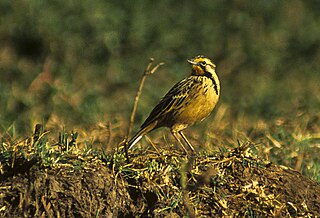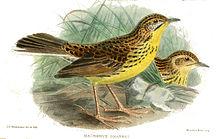
Wagtails are a group of passerine birds that form the genus Motacilla in the family Motacillidae. The common name and genus name are derived from their characteristic tail pumping behaviour. Together with the pipits and longclaws they form the family Motacillidae.

The pipits are a cosmopolitan genus, Anthus, of small passerine birds with medium to long tails. Along with the wagtails and longclaws, the pipits make up the family Motacillidae. The genus is widespread, occurring across most of the world, except the driest deserts, rainforest and the mainland of Antarctica.

The wagtails, longclaws, and pipits are a family, Motacillidae, of small passerine birds with medium to long tails. Around 70 species occur in five genera. The longclaws are entirely restricted to the Afrotropics, and the wagtails are predominantly found in Europe, Africa, and Asia, with two species migrating and breeding in Alaska. The pipits have the most cosmopolitan distribution, being found mostly in the Old World, but occurring also in the Americas and oceanic islands such as New Zealand and the Falklands. Two African species, the yellow-breasted pipit and Sharpe's longclaw, are sometimes placed in a separate seventh genus, Hemimacronyx, which is closely related to the longclaws.

The longclaws are a genus, Macronyx, of small African passerine birds in the family Motacillidae.

The European rock pipit, or simply rock pipit, is a species of small passerine bird that breeds in western Europe on rocky coasts. It has streaked greyish-brown upperparts and buff underparts, and is similar in appearance to other European pipits. There are three subspecies, of which only the Fennoscandian one is migratory, wintering in shoreline habitats further south in Europe. The European rock pipit is territorial at least in the breeding season, and year-round where it is resident. Males will sometimes enter an adjacent territory to assist the resident in repelling an intruder, behaviour only otherwise known from the African fiddler crab.

The water pipit is a small passerine bird which breeds in the mountains of Southern Europe and the Palearctic eastwards to China. It is a short-distance migrant; many birds move to lower altitudes or wet open lowlands in winter.

The tree pipit is a small passerine bird which breeds across most of Europe and the Palearctic as far East as the East Siberian Mountains. It is a long-distance migrant moving in winter to Africa and southern Asia. The scientific name is from Latin: anthus is the name for a small bird of grasslands, and the specific trivialis means "common".

Richard Bowdler Sharpe was an English zoologist and ornithologist who worked as curator of the bird collection at the British Museum of natural history. In the course of his career he published several monographs on bird groups and produced a multi-volume catalogue of the specimens in the collection of the museum. He described many new species of bird and also has had species named in his honour by other ornithologists including Sharpe's longclaw and Sharpe's starling.

The forest wagtail is a medium-sized passerine bird in the wagtail family Motacillidae. It has a distinctive plumage that sets it apart from other wagtails and has the habit of wagging its tail sideways unlike the usual up and down movements of the other wagtail species. It is the only wagtail species that nests in trees. It is found mainly in forested habitats, breeding in the temperate parts of east Asia and wintering across tropical Asia from India to Indonesia.

The Cape longclaw or orange-throated longclaw is a passerine bird in the family Motacillidae, which comprises the longclaws, pipits and wagtails. It occurs in Southern Africa in Zimbabwe and southern and eastern South Africa. This species is found in coastal and mountain grassland, often near water.

The Cape wagtail, also known as Wells's wagtail, is a small insectivorous bird which is widespread in southern Africa. It frequents water's edge, lawns and gardens. It is a mostly resident, territorial species, but has been known to undertake limited altitudinal migration or form flocks outside of the breeding season. Like other wagtails they are passerine birds of the family Motacillidae, which also includes the pipits and longclaws.

The grey penduline tit, also known as the African penduline-tit, is a species of bird in the family Remizidae. It is found in Angola, Botswana, Burundi, Republic of the Congo, Democratic Republic of the Congo, Eswatini, Kenya, Malawi, Mozambique, Namibia, Rwanda, South Africa, Tanzania, Uganda, Zambia, and Zimbabwe. Its natural habitats are subtropical or tropical dry forests, dry savanna, and moist savanna. At 8 to 9 cm in length and a weight of 6.5 g (0.23 oz), it is one of the smallest species of bird found in Africa, along with its cousin the Cape penduline tit and the perhaps smaller mouse-colored penduline tit and the tit hylia.

The rosy-throated longclaw, also known as the rosy-breasted longclaw is a species of bird in the family Motacillidae. It is found in Angola, Botswana, Democratic Republic of the Congo, Kenya, Malawi, Mozambique, Namibia, South Africa, Tanzania, Zambia, and Zimbabwe. Its natural habitat is subtropical or tropical seasonally wet or flooded lowland grassland.

The Pangani longclaw is a species of bird in the family Motacillidae, which includes the pipits and wagtails. It is found in Tanzania, Kenya and Somalia. The bird's natural habitats are dry savanna and subtropical or tropical dry lowland grassland.

The yellow-throated longclaw is a species of bird in the family Motacillidae.

The Abyssinian longclaw is a species of bird in the family Motacillidae.

Sharpe's akalat is a species of bird in the family Muscicapidae. It is found in Tanzania and northern parts of Zambia and Malawi. Its natural habitats are boreal forests and subtropical or tropical moist montane forests.
Hemimacronyx is a proposed genus of birds in the pipit and wagtail family Motacillidae. It contains two species that are usually treated as belonging to two larger genera, Macronyx and Anthus. The plumage of the two species is more similar to that of the longclaws and the golden pipit, having brown barred backs and bright yellow breasts and throats. They are presumed to be closely related to these two groups, but the split has not been widely recognised. Both species are found in open areas of Africa. They are both threatened with extinction due to human activities, principally habitat loss.

The eastern yellow wagtail is a small passerine in the wagtail family Motacillidae, which also includes the pipits and longclaws. It was often classified as a subspecies of the Western yellow wagtail. It breeds in the eastern Palearctic and Alaska and migrates to South Asia and Australia.

The East African montane moorlands is a montane grasslands and shrublands ecoregion which occupies several high mountain peaks in Kenya, South Sudan, Tanzania, and Uganda.





















